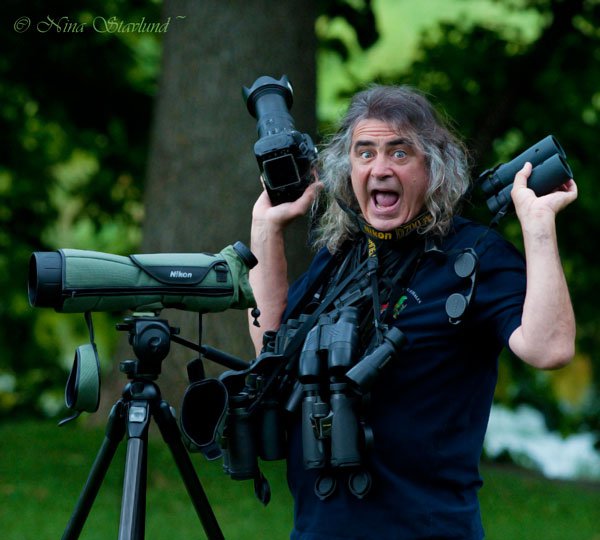Choosing Binoculars for Birding, and How to Properly Focus Them
Choosing Binoculars for Birding, and How to Properly Focus Them
Birdwatching is one of the world’s fastest-growing outdoor activities.
However, to maximize your enjoyment of watching birds, you’ll definitely need a good pair of binoculars.
There are so many different types to choose from that it can be a daunting task to select exactly what you need. For birding, I recommend something that’s comfortable, sturdy, provides a bright view, is razor-sharp and crystal clear.
The three main design styles include Roof Prism, Porro Prism and Field Glasses. Unfortunately, Field Glasses don’t have a central focusing knob. Instead, each barrel is focused separately making them inefficient for most birding situations. Although all the different styles can perform well optically, modern Roof Prism designs are the most popular mainly because of their compact shape and overall comfort in the hand. However, what works best for you is usually a personal choice. If possible, try as many different types as you can before you invest.
Good binoculars have coatings covering their lenses and prisms. These ultra-thin layers help improve the accuracy of light as it travels through the barrel to your eyes. Coatings increase brightness and clarity while preventing various types of distortion. The more glass surfaces that have coatings applied to them, the better. Normally, the highest quality models have coatings on all lens and prism surfaces.
Binoculars are measured mainly by two numbers separated by “X”. The first number is the magnification. The second number is the diameter of the objective lens (the glass elements at the end of the binocular that are furthest from your eyes) measured in millimeters. For example, an 8 X 42 binocular magnifies 8 times, and each objective lens is 42mm across.
Generally, big objective lenses mean brighter (more light-gathering ability) and wider fields of view. However, wide objective lenses mean larger size and more weight. As magnification increases, your field of view narrows and you lose brightness. For example, a 7 X 50 binocular will be very bright with a great field of view while a 10 X 22 model will be fairly dark with a very narrow field of view. Most birders use something in between these two extreme examples.
Generally, bigger is rarely better. The most popular models range between 7 & 10 power magnification. 8 power roof prism binoculars are the most popular amongst birders. They’re especially good for beginners since higher magnifications can be more difficult to use without steady hands and some prior experience. After years of practice, you might consider moving up to 10 power. Currently, my favourites are the Monarch 10 X 30 HG. Since I carry a lot of equipment into the field, especially while entertaining clients, the compact 10 X 30 Monarchs are fairly lightweight and comfortable while still performing incredibly well.
Not all binoculars have close-focus capability. Birders and naturalists should consider this before making a choice. Although you will use them primarily for seeing things at a distance, the ability to focus close might come in handy when trying to identify insects, flowers, or viewing extremely subtle plumage details on birds skulking through tall grass at your feet.
Eyeglass wearers should roll or screw the eyecups down when using binoculars. This puts the eyepiece closer to your glasses bringing your eyes to an ideal distance from the eyepieces. This allows your eyes to achieve the widest possible view (called “Eye Relief”) while still protecting the surface of your eyeglasses.
For additional comfort, especially if you find binoculars heavy or interfering, add a binocular harness. This accessory is a fancy strap that fits over your shoulders and crossing your back. It holds your optics close to the chest, distributing its weight over a larger area while still allowing you to lift the binoculars quickly and effortlessly.
Before you buy, consider manufactures warranty. Some models (like the Nikon Monarchs) come with a no-fault lifetime replacement. This means your next binocular purchase should be your last, at least until you upgrade, or treat a good friend to a birthday gift.
Maximize the performance of your investment. Many people think focusing binoculars is a simple matter. However, I can’t overemphasize the importance of properly calibrating binoculars for your personal vision. Even with the most expensive models on the market, you must first go through the exercise of focusing both barrels for your own eyes. We all have a difference in the way our eyes focus. Every time you use a new or different binocular, you should adjust them for your own personal vision.
Below in the text, and in the video, is the focusing exercise for a Nikon Monarch 8 X 42 model.
However, not all binoculars are designed the same. So read your owners-manual to make sure you’re doing the exercise properly.
Step 1 – Find the central focus knob and the focusing wheel on the eyepiece. Determine which of the two barrels of the binocular has the focusing eyepiece. The Monarchs have the eyepiece focusing wheel on the right barrel.
Step 2 – look through the binocular and adjust the two barrels about the hinge until it fits comfortably against your eyes.
Step 3 – Pick a stationary reference spot at about 10 or 15 meters away (eg: tree trunk or street sign). Shut the right eye (the eye corresponding to the focusing eyepiece) and focus with the central focus knob. Once your reference point is 100% in focus, take your hands away from the focusing knob and don’t touch it until the adjustment is complete.
Step 4 – From the same vantage point, shut the left eye, and focus the right barrel using only the eyepiece adjustment wheel. Once your reference spot is 100% in focus, take your hands away from the eyepiece adjuster.
Both barrels should now be perfectly adjusted to your vision. And, both eyes should simultaneously achieve perfect focus by only adjusting the central focusing knob.
Now, get out there and enjoy the beauty of our natural world with a high-quality, properly calibrated pair of binoculars.



